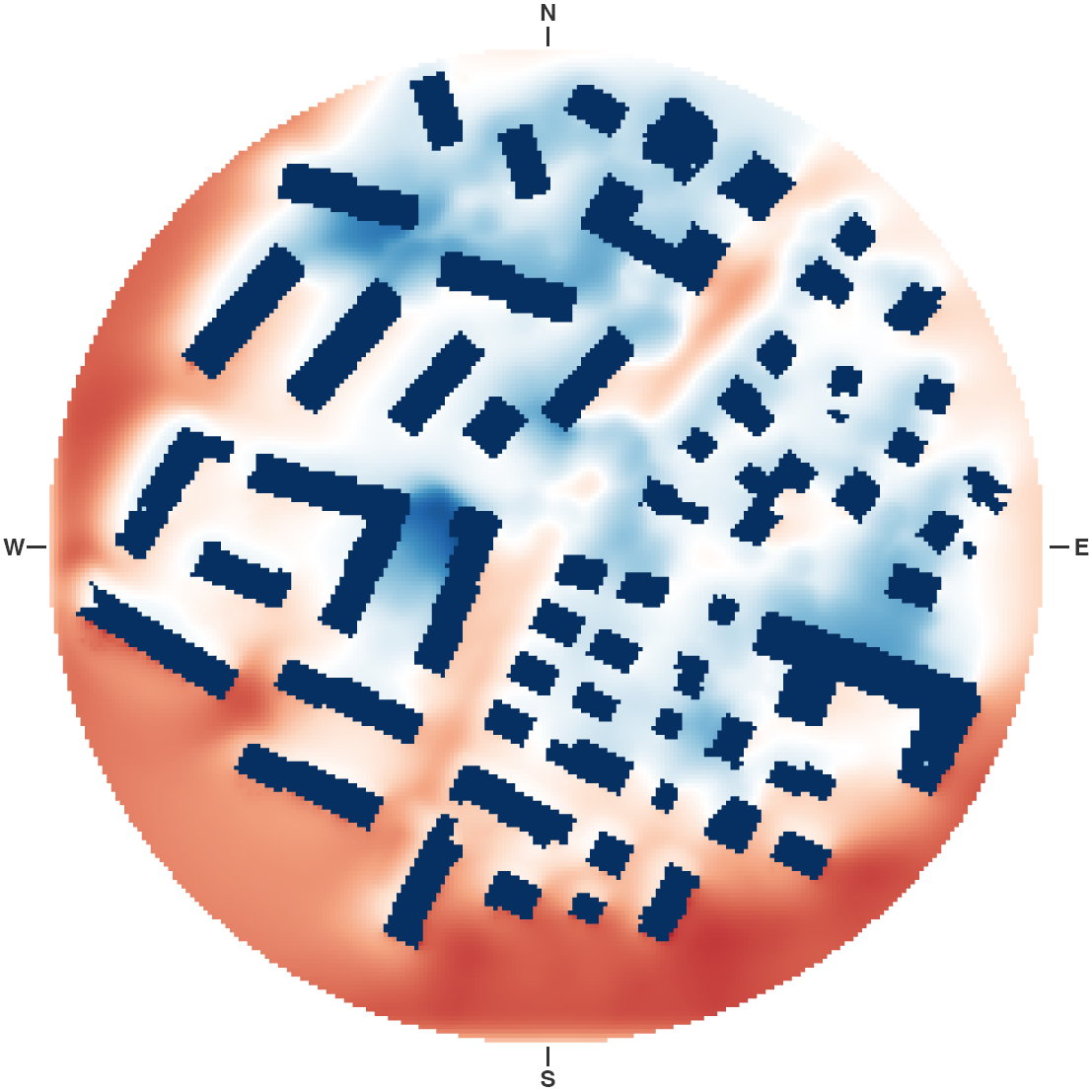This work package focuses on energy-related aspects of urban BIPV, as well as on architectural design questions. Tasks span from developing simulation and generative methods to designing technical and architectural solutions:
High-resolution PV models: Developing a high-resolution model suited for specific conditions present on facades. Capturing the impact of partial shading down to the cell level, integrating electrical models and (dynamic/adaptive) string layout, comparison of cell efficiency models, and adaptations to different cell technologies. Conducting experiments to validate and calibrate numeric models.
Microclimate & BIPV: Studying the impact of BIPV facades on the local microclimate and on urban heat islands (UHI). Vice versa, assessing the impact of local airflow and temperatures on PV performance. Conducting computational fluid dynamics (CFD) simulations to assess urban design and climate scenarios. Conducting experiments to collect measurement data for validating and calibrating CFD simulations, as well as for developing physics-informed numeric models.
Generative Solar Design: Leveraging data-driven techniques for performance prediction, as well as for design generation. Such approaches allow the mitigation of uncertainties and limited information in engineering. Specifically, we will develop physics-informed models for PV potentials and urban energy, able to capture urban conditions efficiently. Furthermore, generative methods for BIPV facades and optimization models for distributed energy resources (DER) will be developed as decision-support tools.
PV Deployment & Retrofitting: Application of models to case studies in Zurich and Singapore (retrofit and brownfield), assessing large-scale deployment of BIPV under realistic urban conditions (incl. policies and legislation) and future scenarios. Multi-energy systems models to assess the feasibility of urban-scale BIPV deployment in conjunction with other DERs (e.g., storage systems, district heating/cooling) and retrofitting interventions (fabric and building systems).


POW Energy & Design
The difference between local building electricity demand and local solar electricity generation potential for the district of Altstetten in Zurich.
Team /
Dr. Christoph Waibel, Justin McCarty, Ayca Duran, Maximilian Gester, Dr. Shin Woei Leow, Prof. Dr. Arno Schlueter
Publications /
1 / J. McCarty, C. Waibel, and A. Schlueter, “Detailed Modeling Framework for Integrated Photovoltaic in Partial Shading Conditions,” in ECOS 2023
2 /J. McCarty, C. Waibel, and A. Schlueter, “High-resolution Vegetation Proxy Modeling for Partial Shading Effects on BIPV Facades,” in 21st International Radiance Workshop, Innsbruck, 2023.
3 / J. McCarty, “MESA: Morph EPWs Simply Anywhere,” 2023. [Online]. Available: www.morphepw.app
4 / J. McCarty, A. Schlueter, and A. Rysanek, “Assessing the impact of morphed CMIP6 climate model outputs on building energy performance simulations,” in CISBAT 2023, 2023.
5 / A. Duran, C. Waibel, and A. Schlueter, “A parametric approach to evaluate the impact of BIPV facades on outdoor thermal comfort in different urban forms,” in Building Simulation 2023, Shanghai, 2023
6 / R. Vecchiarelli, M. Kraus, D. Griego, and C. Waibel, “Urban airflow prediction by pix2pix trained on FFD,” in CISBAT 2023,
7 / Y. Zhang, A. Schl ̈uter, and C. Waibel, “SolarGAN: Synthetic Annual Solar Irradiance Time Series on Urban Building Facades via Deep Generative Networks,” Energy and AI journal, vol. 12, p. 100223, 2023. [Online]. Link.
8 / A. Duran, C. Waibel, and A. Schlueter, “Pix2pix to estimate surface utilization factors of street captured fa ̧cade images for BIPV applications,” in CISBAT 2023.
9 / Zhang, C. Waibel, and A. Schl ̈uter, “Stochastic Solar Irradiance from Deep Generative Networks and their Application in BIPV Design,” in SBE 22, Berlin, 2022.
10 / C. Waibel, S. Hsieh, and A. Schl ̈uter, “Impact of demand response on BIPV and district multi-energy systems design in Singapore and Switzerland,” in Journal of Physics: Conference Series CISBAT 2021, vol. 2042, no. 1, Lausanne, Switzerland, 2021.
11 / J. McCarty, C. Waibel, and A. Schlueter, “Multi-Period Optimisation of District-Scale Building Integrated Photovoltaic Deployment,” in SBE 23, Thessaloniki, 2023
12 / J. McCarty, C. Waibel, and A. Schlueter, “Altstetten demand and potentials map,” 2023. [Online]. Link.
13 /J. McCarty, C. Waibel, and A. Schlueter, “The repository for integrated solar energy in the built environment,” 2022. [Online]. Link.
14 / A. Bufacchi, A. Schlueter, G. Mavromatidis, and C. Waibel, “Interaction effects between building- and multi-energy systems design variables,” in Building Simulation 2021, Bruges, Belgium, 2021.



